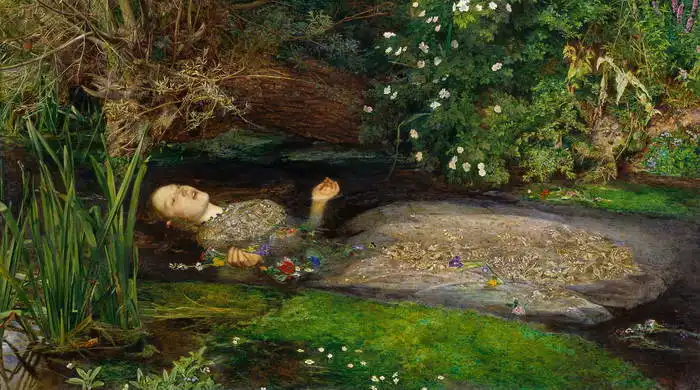About this finishing
Print. The image is printed on the top quality 10-ink HP Z9PS printer on HP matte 270 g / m2 paper. You can choose any size to an accuracy of 1 cm. A margin of 5 cm around the image is added to the size of the motif.


You can find a detailed description about our finishings
here.
Ophelia
"Ophelia" is a famous painting by British Pre-Raphaelite painter
John Everett Millai created in 1851-1852. This painting is inspired by the character Ophelia from William Shakespeare's tragedy "Hamlet". Millaie's distinctive Pre-Raphaelite style is evident in his emphasis on detail, symbolism and realistic accuracy.
In the foreground of the painting lies a young woman, Ophelia, who drowned in the lake. Her character is captured in a completely
realistic and detailed depiction. Ophelia wears a crown of flowers and appears to be limp and peaceful. The plants and
flowers in the painting have a symbolic meaning. For example, daisies, which are scattered on the surface, symbolize innocence and youth. The roses Ophelia holds in her hand represent love. Some of the flowers also have associations with specific characters or situations from "Hamlet". The painting is arranged to create an impression of calm and harmony, which contrasts with Ophelia's tragic fate. Her figure is placed in the center of the painting, while water and plants surround her.
The water around Ophelia is full of flowers and plants, which are depicted with careful attention to botanical accuracy. Each type of plant has its own symbolism and represents different aspects of the story and Ophelia's fate.
Prevailing color of this fine art print is green and its shape is long. This image is printed on demand - you can choose material, size and finishing.
Sir John Everett Millais (1829-1896) was an English
Classicist painter and illustrator who was born in Southampton, England. He was the youngest student of the Royal Academy of Arts. His prominent family supported him, which greatly benefited his reputation. He was a founding member of the Pre-Raphaelite brotherhood, to which another English artist,
Ford Madox Brown, later belonged. Millias’ works were highly controversial: for example, the image
Christ in his Parents’ House shows the Holy Family working in a carpentry workshop. His early works are characterized by a great attention to detail and the beauty of nature. Another of his works,
Mariana, was inspired by William Shakespeare’s play. In 1855, he married the wife of his friend, John Ruskin. They had eight children. After marriage, Millias changed his style to better support his large family. He was inspired more by old masters such as Diego Velazquez. He tried to project their style into his historical paintings (eg. < a href=millais-john-everet-pizarro-porazi-inky-v-peru-ido-5443> Pizzaro Defeats the Incas in Peru). He spent his old age painting bleak and hardly accessible landscapes.


